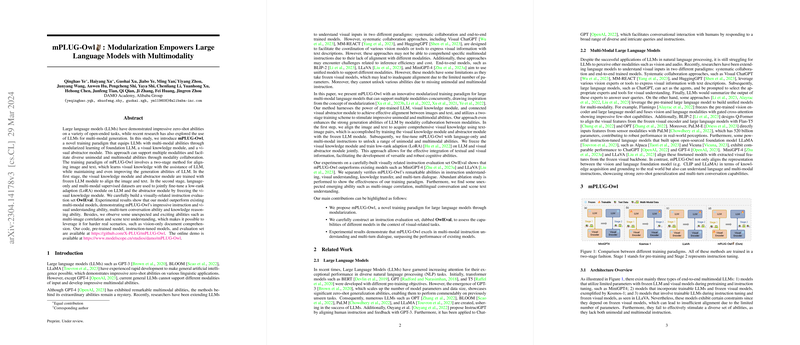Overview of mPLUG-Owl: Modularization for Multi-Modality in LLMs
The paper "mPLUG-Owl: Modularization Empowers LLMs with Multimodality" explores an innovative paradigm for enhancing LLMs with multimodal capabilities through a modularized training approach. This paper addresses the integration of visual information into LLMs, a challenging area given the traditionally text-centric focus of such models.
Methodology
mPLUG-Owl employs a modularized architecture comprising three core components: a foundation LLM, a visual knowledge module, and a visual abstractor module. This structure allows for effective alignment and integration of image and text data. The training process is divided into two stages:
- Visual Knowledge and Alignment: The initial stage involves training the visual modules with a frozen LLM to align visual and textual data. This step ensures the acquisition and internalization of visual knowledge using text-image pairs.
- Joint Instruction Tuning: The second stage utilizes a combination of language-only and multimodal datasets to fine-tune a low-rank adaption module on the LLM and the visual abstractor, with the visual knowledge module remaining frozen. This phase enhances both unimodal and multimodal capabilities, promoting robust cognitive abilities in the model.
Experimental Results
Upon evaluation using the custom-built OwlEval dataset, mPLUG-Owl demonstrated superior performance compared to other multimodal models like MiniGPT-4 and LLaVA. Key areas of testing included instruction understanding, visual comprehension, knowledge reasoning, and multi-turn conversation. The model also exhibited unexpected abilities in handling tasks such as multi-image correlation and scene text understanding, suggesting potential for more complex applications like vision-only document comprehension.
The paper provides a detailed comparison of mPLUG-Owl’s performance with existing models, showcasing its proficiency across various metrics.
Implications and Future Directions
The introduction of mPLUG-Owl represents a significant advancement in bridging the gap between visual and textual modalities within LLMs. The use of modularization not only empowers these models with enhanced visual understanding but also preserves and potentially improves their generative capabilities. This approach opens avenues for more sophisticated AI systems capable of handling intricate multimodal instructions and scenarios.
Future research may explore extending the current model’s capabilities further, particularly in areas like multilingual processing and complex scene interpretation. As the field progresses, such modular frameworks could become foundational in the development of AI systems that interact seamlessly across various forms of media and language.
Conclusion
The modular training paradigm of mPLUG-Owl presents a promising direction for integrating multimodality into LLMs. By maintaining the strengths of LLMs and augmenting them with powerful visual modules, this research contributes significantly to the advancement of AI technologies capable of understanding and generating across multiple modalities.
